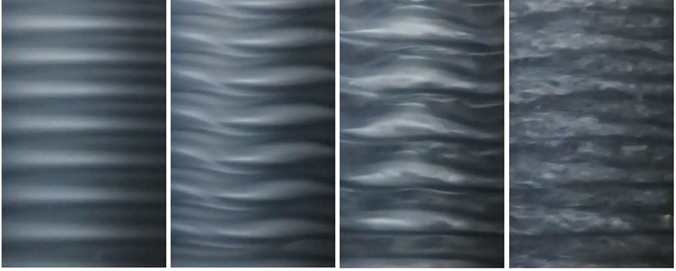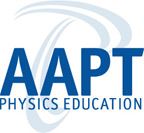- Home
- What We Do
- Laboratory Immersions
- Immersions 2018
- Imm2018Willamette_TaylorCouette
Flow Instabilities in Taylor-Couette Flow
Willamette University (Salem, OR), August 8 – 10, 2018

Figure 1. Basic Taylor-Couette cell.
The basic apparatus consists of two coaxial cylinders. The gap between them is filled with fluid and the inner cylinder is made to rotate by a stepper motor (see Fig. 1). For low rotation rates, viscosity causes the fluid to flow as might be predicted from symmetry. Fluid elements follow circular paths and the flow field has no axial or azimuthal dependence. However, as the rotation rate of the inner cylinder is increased the flow suddenly undergoes an instability and a cellular pattern of toroidal vortices called Taylor rolls emerges. As the rotation is increased further, the Taylor rolls themselves become unstable giving way to a progressively more complicated flow states as shown in Fig. 2, eventually leading to turbulence.

Figure 2. As the rotation rate of the inner cylinder is increased (left to right), the flow undergoes bifurcations from Taylor rolls to progressively more complex and eventually turbulent flows.
During the first half (1-1.5 days) of the Immersion participants will build a small Taylor-Couette apparatus and learn how the design and construction of the apparatus can be implemented as a series of instructional modules on digital electronics, computer-aided design (CAD), conventional and modern fabrication methods (soldering, machining, laser cutting, 3D printing, etc. as appropriate to participant’s home institutions), scientific image acquisition, and digital image/signal processing. The apparatus can be used as a stand-alone unit or be interfaced with a computer for more precise control.
During the second half of the Immersion (1-1.5 days), participants will learn how the Taylor-Couette system can be used to demonstrate a host of important topics in fluid mechanics and nonlinear dynamics as stand-alone classroom demonstrations, laboratory exercises, or extended student projects. Some of the topics that will be explored include flow visualization, Reynolds similarity, flow instabilities, the time reversibility of low Reynolds number flows, the coexistence of attractors in nonlinear systems, the Ruelle-Takens route to chaos, and attractor reconstruction from time series.
Participants should bring their lab notebook and a flash drive. Although computers will be available, participants may find it useful to use their own laptops.
There are no special safety considerations besides the usual hazards involved in working with hand and machine tools.
Upon completion of the Immersion, participants will have a working Taylor-Couette apparatus to take back to their home institutions. Additional units can be constructed as student projects for ~$150 per unit. Most of the parts can be re-used, so the design and construction of the apparatus can be implemented as a project-based activity in subsequent semesters at significantly lower cost. While the Taylor-Couette system can be used to perform most of the experiments as a standalone unit, additional equipment ranging in cost from $200 to $2000 is necessary to conduct some of the experiments.

Daniel Borrero received his BS in Physics from the University of Texas at Austin and his PhD in Physics from Georgia Tech. After receiving his PhD, Daniel taught at Reed College, where he worked to restructure the instrumentation laboratory course using a project-based curriculum. In 2016, Daniel joined the Department of Physics at Willamette University. At Willamette, he has continued to research fluid systems with complex spatiotemporal dynamics. In particular, his research focuses on studying the subcritical transition to turbulence in wall-bounded shear flows. He has taught courses across the physics curriculum and has recently been involved with departmental efforts to introduce scientific computation to the introductory physics sequence. Daniel was also part of the 2010 Hands-on Research in Complex System School at the University of Buea in Cameroon, where he taught sessions on studying flow instabilities and transitional flows using low-cost table-top experiments and computational modeling using Python to graduate students and faculty from over 50 African countries.
Daniel Borrero-Echeverry, Willamette University, Department of Physics, 900 State St., Salem, OR 97301. Email: dborrero@willamette.edu. Phone: 503-370-6753.






